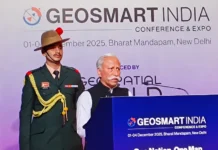[ MC Behera ]
On 19 March, 2020, at 8 pm, Prime Minister Narendra Modi introduced the concept of ‘janta curfew’ as one of the preventive measures against the pandemic caused by the coronavirus (Covid-19). Since December 2019, after its detection in Wuhan city of China, the virus has become a global concern.
Covid-19 is a matter of serious concern because no medicine is available yet for its cure. However, two crucial steps are advised to control it. First, when any of the symptoms appear, it is essential and advisable to visit Covid-19 test centres. However, it is not possible and practicable for all, particularly people of rural and hill areas, as they do not have easy access to such centres. Moreover, such facilities are limited and at present set up in urban centres.
Therefore, the second step is of great importance. It advises to keep oneself in isolation when any symptom(s) appears. Self-isolation has two greater advantages. It will be confirmed whether the initial symptom(s) is/are of Covid-19 or not if the situation does not improve within a week or so. In case of Covid-19, the condition will worsen; more symptoms will appear as days go by, including breathing difficulty. Breathing will be short; it is the indication of a severe case and requires immediate medical attention.
Media reports inform that those who have been identified as coronavirus positive in India are from among visitors to or from foreign countries infected with Covid-19. That is why the outbreak in India with more cases is noted in urban centres like Mumbai, Bengaluru, Hyderabad, Delhi, and others. In other places of India, the registered cases of coronavirus positive also show a foreign trip.
It is shocking to note that the people about whom India takes pride due to their global representation of the country are carriers of a global threat to common people. More shocking is their imprudence and their neglecting their responsibility to the society at large, which has been a concern. The recent case of Bollywood singer Kanika Kapoor is a burning example. Despite advice of quarantine, she participated in public events and came in contact with VVIPs, VIPs and lawmakers of the country and other celebrities. Most of them are public figures and thus can be carriers of the disease to the public at large.
But what seems alarming is that in the very near future, Covid-19 is likely to spread to rural areas if people themselves do not understand their responsibility and duty as citizens. A carrier of the virus should understand that he/she should not be the cause of its spread to others. Second, he/she should take care of his/her own life. The concern of its spread in rural areas emanates from the fact that many villagers work in cities where Covid-19 has already entered. These migrant labourers have started to return to their villages. The possibility that a few of them may carry the virus cannot be overruled.
As has been stated, no medicine or vaccination is available for the treatment of the disease, though researches are going on. Only isolation is found to be the effective means at present to contain its spread and prevent its occurrence. Therefore, all over the world, steps have been taken to ensure isolation, segregation, etc. Wuhan city has been cordoned off, entry and exit being restricted. This practice is adopted in other cities, particularly in affected countries, who work towards ensuring isolation, segregation, restriction of movement, etc, so that people don’t come in contact with any affected person(s).
It has worked wonders. Singapore and even Wuhan city have been able to control the spread by such measures. As on 21 March, no case of Covid-19 was reported in Wuhan within a period of 24 hours.
In India, pilgrimage and religious places have been closed or visit restricted; schools, colleges, offices, etc, have been closed, international flights, many domestic flights, trains, etc, have been cancelled; malls, big bazaars, etc, have been closed; and several national and international events like the IPL have been postponed/cancelled. A large percentage of employees have been advised to work from home. In fact, more than 35 percent of people have started working from home. The government is doing its best for us, but it is our contribution to the effort which carries weight in the global fight against Covid-19.
In India, the PM’s call for a ‘janta curfew’ is a well-thought-out strategy towards mass isolation, segregation and maintaining distance from affected persons. The main purpose is to control the spread of the disease and to help cure the disease through isolation. This call is in the line of global trend as the disease is global, a pandemic. But in Modi’s call, the spirit appeals to traditions which many communities still celebrate.
By discussing Covid-19, its symptoms, and curative steps, my intention is not to create or reiterate awareness per se in the line of various agencies. The governments, media, NGOs, institutions and companies and celebrities are already into the job and doing yeoman service. I have taken this ‘awareness campaign’ as the base to create awareness in the field of academics in order to understand human civilization as a continuity and holistically.
From the above discussions two crucial points emerge – first, isolation and second, as a corollary, working at home.
‘Janta curfew’ is essentially a mode of popularizing isolation. Three questions arise. Did the isolation strategy appear for the first time in medical history? Second, is it an innovation of modern scientific thought? Third, is the practice of ‘work at home’ new in livelihood pursuits? Let us try to understand with reference to jana who are, as it is believed, on the other side of western sense of modernity.
Jana, who are now known as tribes in academic parlance and scheduled tribes (ST) in the constitution of India, constitute an inalienable part of India’s social structure; the other component in the binary opposite being Jati. But both complement each other to comprehended India’s social structure as a unity. Whether jati evolved from jana or not is not the point of debate. What is important is that the practices which exist in non-literate communities also exist in literate scientific traditions and even in modern medical practices. The reference is to isolation as a remedial measure among the jana/tribes; jatis, particularly among rural folks and in modern medical system. Quarantine ward in hospitals is a better example.
The practice that exists both in modern and traditional societies of distant past cannot be something of a top-down transmission. It claims further insight into the proposition and investigation. However, any person interested in tribal studies knows various taboos observed among the tribes. When an epidemic breaks out in a village, the villagers do not move out of their house/village boundary. Entry of members of other villages is strictly prohibited. Evidently, any member of an epidemic affected village is not allowed to enter other villages as it is believed that he/she will cause the disease in unaffected villages.
So is the case when a family observes taboos relating to curative ritual. In the Northeast, the term ‘genha’ is popular across the tribes, though each tribe has its own term for such prohibitions or taboos, having the essence of isolation at the core. Practice of isolation restricts movement and thus contact between affected and non-affected persons. Besides physical restriction, tribal sense of isolation also has restrictions on food, works, etc. It also connotes to purity and pollution notion.
Understandably, the notion of isolation among the jana/tribes is comprehensive and inclusive in cultural perspective than the notion of in medical practices.
Needless to say, isolation as heal care practice has its root in tribal mode of thought. Isolation concerning Covid-19 has an element of sanitization. Buses, offices, etc, are sanitized to avoid contact with virus. Tribal curative ritual performed by worshipping a deity or cleaning a scared place, in many parts of the country, has the notion of cleanliness which may resemble the practice of sanitization in modern health care system.
Arguably, the practice of sanitization, isolation, etc, is not a modern innovation; it has its root in tribal communities also. Though the form and philosophy behind it have changed the essence is the same – the relation with curing diseases, particularly epidemic ones. The isolation concept is so related to epidemics in that the whole village shifts to new places to maintain distance from the old site.
Isolation strategy related to Covid-19 has another dimension – ‘work at home’. In fact, working away from home emerged with the emergence of the factory system of production. In tribal communities, the house/village space is the place of production and dwelling. The cloth is woven at home; the agricultural fields/hunting tracts are located within the village territorial boundary. But with factory system of production, community-based residence and workplace differed; a new social order gradually evolved into globalization. With globalization of material and ideological fronts, the evils associated with it also get globalized. Under such a situation, globalization of some diseases requires confinement, isolation, rather than open space interaction for cure. Work at home is an example contrary to the spirit of globalization; just a return to traditional logic at the failure of modern alternative.
It is in fairness of things to argue, with reference to the relevance of isolation concept in the context of treatment of Covid-19, that tribal mode of thought and practices can offer possibilities to address contemporary challenges, though global in nature. In this regard, tribal studies as an independent academic engagement holds great promises to examine the process of human civilization in a holistic perspective that has been blurred by specialized western approach to knowledge system. (MC Behera is a professor of tribal studies.)



